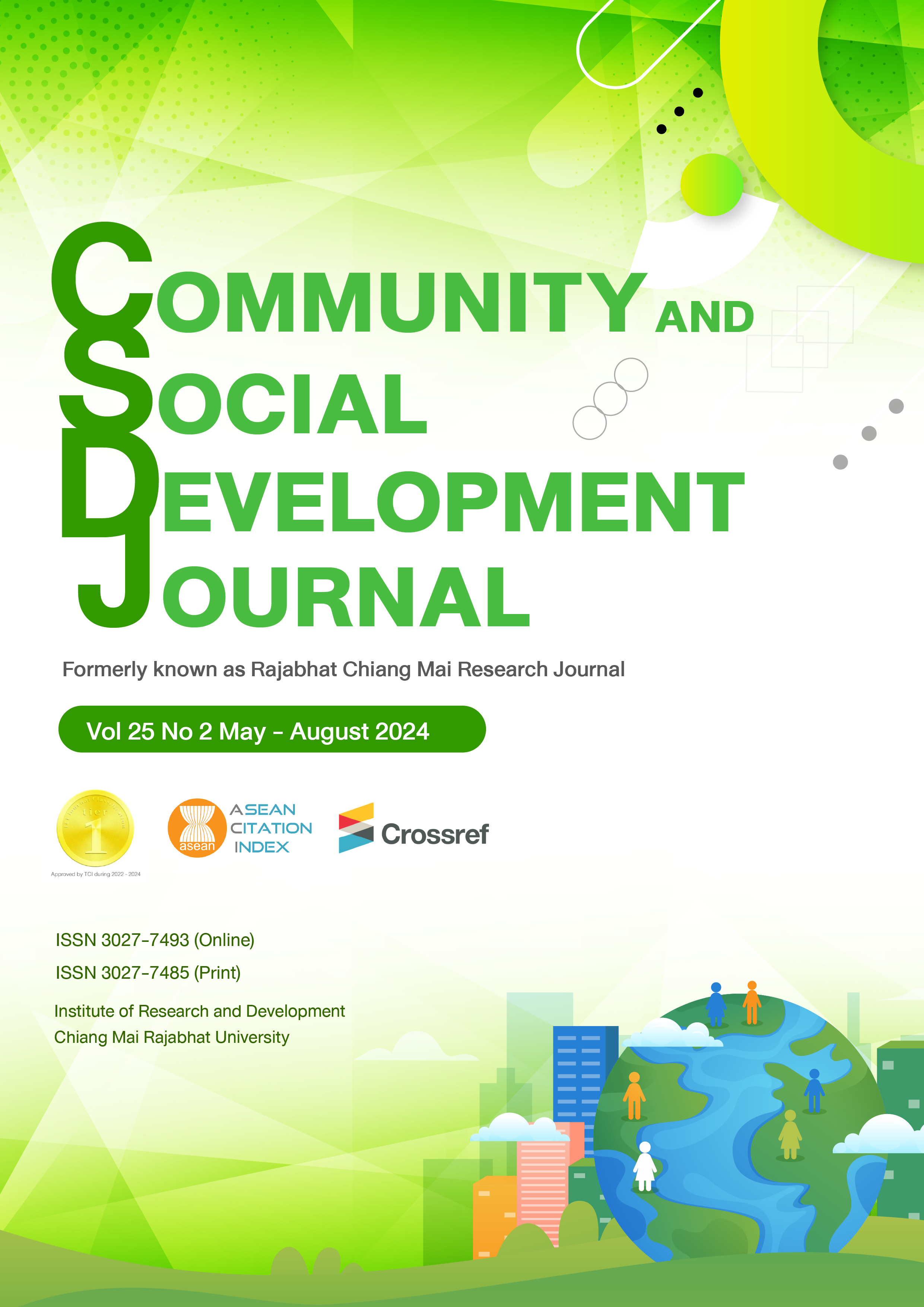Innovation Driven the Professional Learning Community (PLC) Process for Small Educational Institutions and Remote Areas
DOI:
https://doi.org/10.57260/csdj.2024.266793คำสำคัญ:
Innovation, Driven process, Professional learning communityบทคัดย่อ
This study is based on the idea of a professional learning community, which is a group of educators who get together to share teaching insights, gaining managerial expertise through the process of a professional learning community, which facilitates the transfer of information and the planning of operations that will result in actual operations, the PLC process driving model may be used by teachers to conduct research in the classroom on a regular basis and to share the findings with other members of the teaching staff in order to maintain continuity and sustainability. Therefore, this research article aims to; 1) to create innovation to drive the professional learning community process for small educational institutions and remote areas, 2) to apply innovations in driving the professional learning community process to network educational institutions, small educational institutions, and remote areas, and 3) to confirm innovation in driving the professional learning community process for small educational institutions and remote areas.
It is research and development, and the sample was drawn from purposive selection of small educational institutions in Phetchabun Province, Phichit Province, and Nan Province, totaling 7 locations, confirm the format by referencing qualified experts. The tools used in the research include; seminar recording form on innovation creation, workshop project manual, workshop project evaluation form, and opinion questionnaire. Statistics used include; percentage value; average; standard deviation; and analyze content.
The results of the research found that; 1) Innovation driven process of professional learning community for small educational institutions and remote areas that are built there are 6 aspects; management, teacher and personnel development, environment and learning management atmosphere, co-leadership, learning management and professional development and Applying learning outcomes to improve learner quality. Performance before development in high level, mean ( = 4.34, S.D.=0.61) after development at the highest level with an average ( =4.50, S.D.=0.59) an increase of +0.13, 2) Bring innovation to drive process of professional learning community for small educational institutions and remote areas the overall assessment results were at a high level, 3) Confirmed the creation of innovations to drive process of professional learning community for small educational institutes and remote areas it was found that there were several interrelated elements be appropriate. It is feasible, useful and theoretically accurate 100 percentages. The researcher offers the following recommendations on how to apply the research study's findings to promote better educational management; 1) until learners are able to develop themselves to their full potential, driving the professional learning community process for small educational institutions and remote areas should give educational institutions, teachers, and students opportunities to creatively design learning together, this can be done by creating a professional learning community development plan that is clear and appropriate to the context of learners, and 2) teachers should use innovation to guide the process of professional learning communities for distant and small educational institutions, build routine research to be varied, fulfill the requirements of students, and empower students to be social innovators.
Downloads
เอกสารอ้างอิง
Battersby, S. (2015). The culture of Professional Learning Communities and connections to improve Teacher Efficacy and Support Student Learning. Arts Education Policy Review. DOI: https://doi.org/10.1080/10632913.2015.970096
Chaibang, W. (2017). PBL like Nok Kala School. Retrieved from http://lamplaimatpattanaschool.blogspot.com/2012/07/blog-post_21.html.
Dechakup, P., & Yindeesuk, P. (2018). Learning to integrate with PLC for development. Bangkok: Chulalongkorn University.
Dhedchawanagon, K. (2023). Development of Bilingual Teaching Models According to Multicultural Education Approaches Using English and Ethnicity Language. Rajabhat Chiang Mai Research Journal, 24(1), 159-170. Retrieved from https://so05.tci-thaijo.org/index.php/cmruresearch/article/view/263046 DOI: https://doi.org/10.57260/rcmrj.2023.263046
DuFour, R. (2007). Professional learning communities: a bandwagon, an idea worthconsidering, or our best hope for high levels of learning?. Journal of Middle School, 39(1), 4-8. Retrieved from https://doi.org/10.1080/00940771.2007.11461607 DOI: https://doi.org/10.1080/00940771.2007.11461607
Hord, S. M., Roussin, J. L., & Sommers, W. A. (2010). Guiding professional learning communities: inspiration, challenge, surprise, and meaning. California Corwin Press.
Hord, S. M. (2010). Professional Learning Communities: Communities of Continuous Inquiry and Improvement. Southwest Educational Development Laboratory.
Limprasong, N. (2020). Model to Drive of the Professional Learning Community Process. Journal of MCU Peace Studies, 8(5), 1959-1972. Retrieved from https://so03.tci-thaijo.org/index.php/journal-peace/article/view/240912
Limprasong, N. (2020). Integration of Knowledge into Innovation of Teacher 4.0. Journal of MCU Peace Studies, 8 (Supplemental Issue), 251-268. Retrieved from https://so03.tci-thaijo.org/index.php/journal-peace/article/view/240625
Luangsawat, W., Teeravanichtrakul, S., & Rakngam, C. (2018). Factors affecting the achievement student Under the Rayong Primary Educational Service Area Office, District 1. Journal of Education, Mahidol University, Faculty of Education, Mahamongkut Wittayalai, 6(1), 236-254. Retrieved from http://ojs.mbu.ac.th/index.php/edj/article/view/226
Martin, M. (2011). Professional learning communities. In contemporary issues in learning and teaching. London: SAGE Publication Ltd.
Montha, K. (2019). Factors affecting the quality of school education. under the district office primary education Bangkok. Journal of Interdisciplinary Research Graduate Studies, 8(2), 289-296. Retrieved from https://so03.tci-thaijo.org/index.php/JIRGS/article/view/243863
Panich, V. (2012). Ways to create learning for students in the 21st century. (2nd ed.). Bangkok: Siam Commercial Foundation.
Phanich, W. (2012). Teacher learning for students in the 21st century. Bangkok: Sodsri-Sarit Foundation Family.
Phuangsomchit, C. (2017). Professional learning community and guidelines for use in educational institutions. STOU Education Journal, 10(1), 34-41. Retrieved from https://ir.stou.ac.th/bitstream/123456789/712/1/44333.pdf
Stoll, T. L., & Louis, K. S. (2007). Professional learning community. New York, NY: Open university Press.
Theparee, P. (2014). The Development of a Professional Learning Community Model for Elementary Education Teachers. Journal of Silpakorn Education Research, 6(2), 284-296. Retrieved from https://so05.tci-thaijo.org/index.php/suedureasearchjournal/article/view/25906
Yoophakdee, E., & Areerat, W. (2017). Administrative factors affecting the learning community. the profession of a teacher in a school Under the Office of Secondary Education Service Area, Region 30. Journal of Khon Kaen University Research, 5(2), 36-45.Retrieved from https://so04.tci-thaijo.org/index.php/gskkuhs/article/view/99613
ดาวน์โหลด
เผยแพร่แล้ว
รูปแบบการอ้างอิง
ฉบับ
ประเภทบทความ
สัญญาอนุญาต
ลิขสิทธิ์ (c) 2024 Community and Social Development Journal

อนุญาตภายใต้เงื่อนไข Creative Commons Attribution-NonCommercial-NoDerivatives 4.0 International License.
1. บทความ ข้อมูล เนื้อหา รูปภาพ ฯลฯ ที่ได้รับการตีพิมพ์ใน “Community and Social Development Journal” ถือเป็นลิขสิทธิ์ของ Community and Social Development Journal มหาวิทยาลัยราชภัฏเชียงใหม่ และเพื่อให้เผยแพร่บทความได้อย่างเหมาะสมผ่านสื่อสิ่งพิมพ์และอิเล็กทรอนิกส์ ผู้เขียนยังคงถือครองลิขสิทธิ์บทความที่ตีพิมพ์ภายใต้ใบอนุญาต Creative Commons Attribution (CC BY) ซึ่งอนุญาตให้เผยแพร่บทความซ้ำในแหล่งอื่นได้ โดยอ้างอิงต้องอ้งอิงบทความในวารสาร ผู้เขียนต้องรับผิดชอบในการขออนุญาตผลิตซ้ำเนื้อหาที่มีลิขสิทธิ์จากแหล่งอื่น
2. เนื้อหาบทความที่ปรากฏในวารสารเป็นความรับผิดชอบของผู้เขียนบทความโดยตรง ซึ่งกองบรรณาธิการวารสารไม่จำเป็นต้องเห็นด้วยหรือร่วมรับผิดชอบใดๆ














